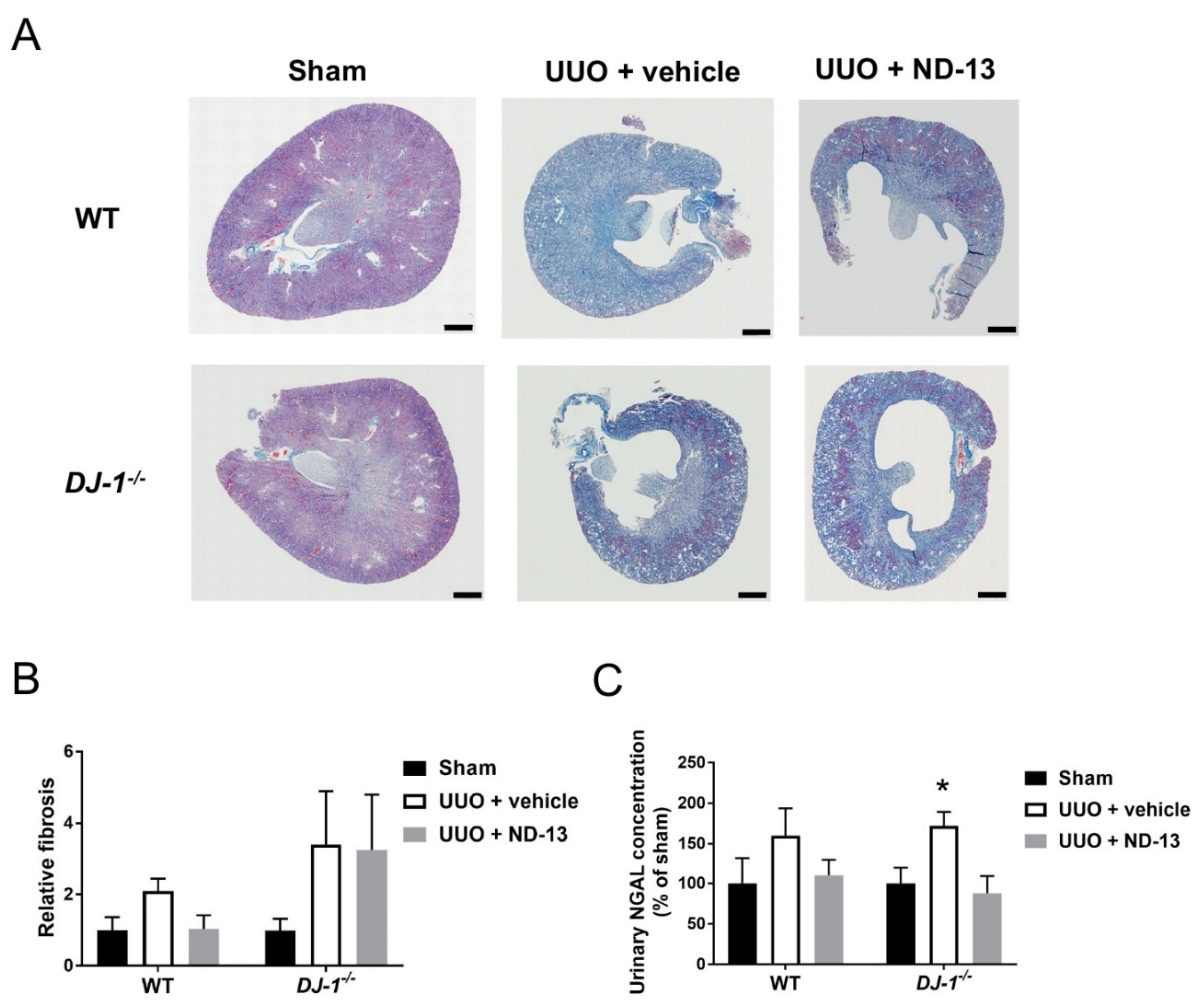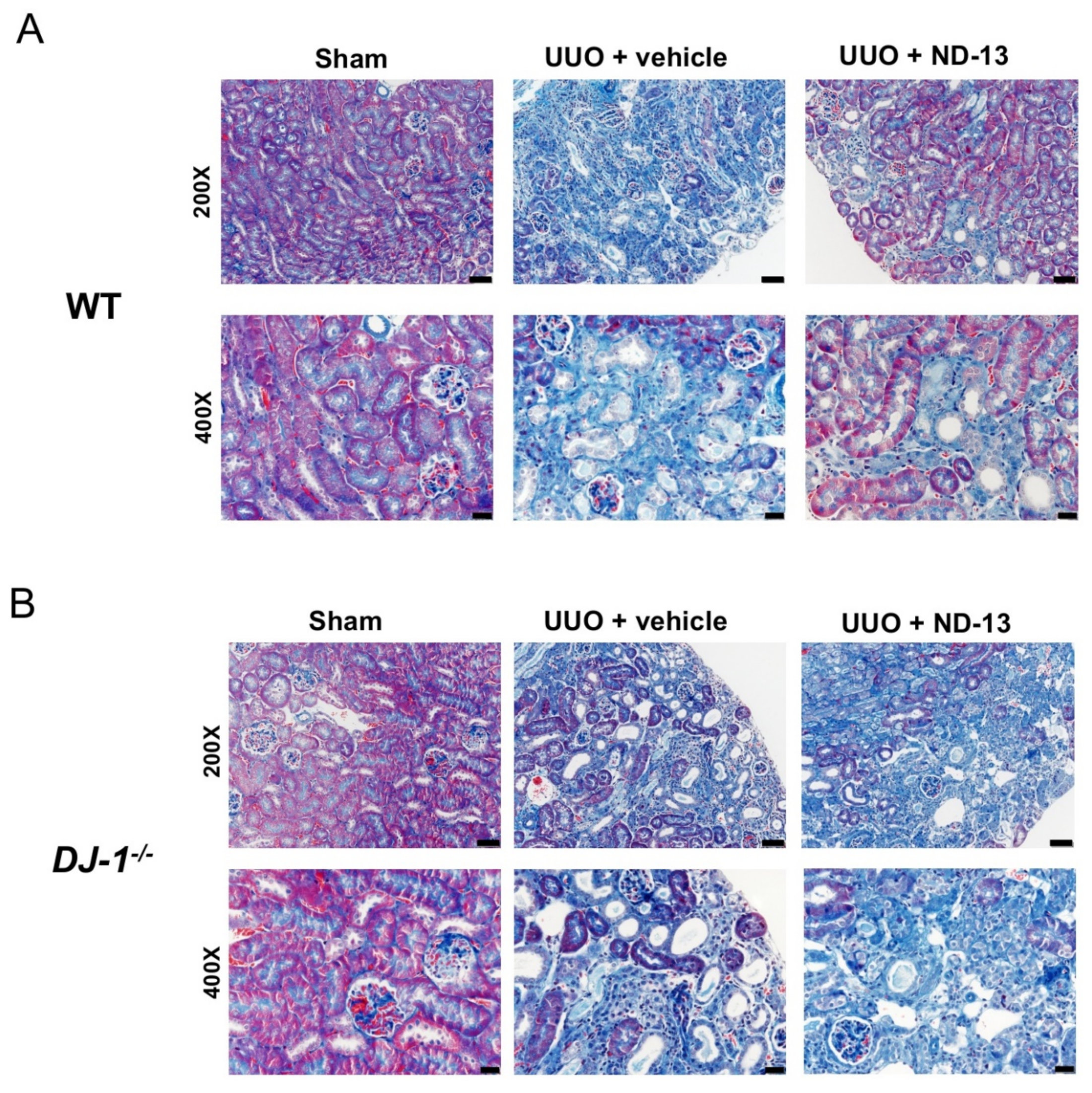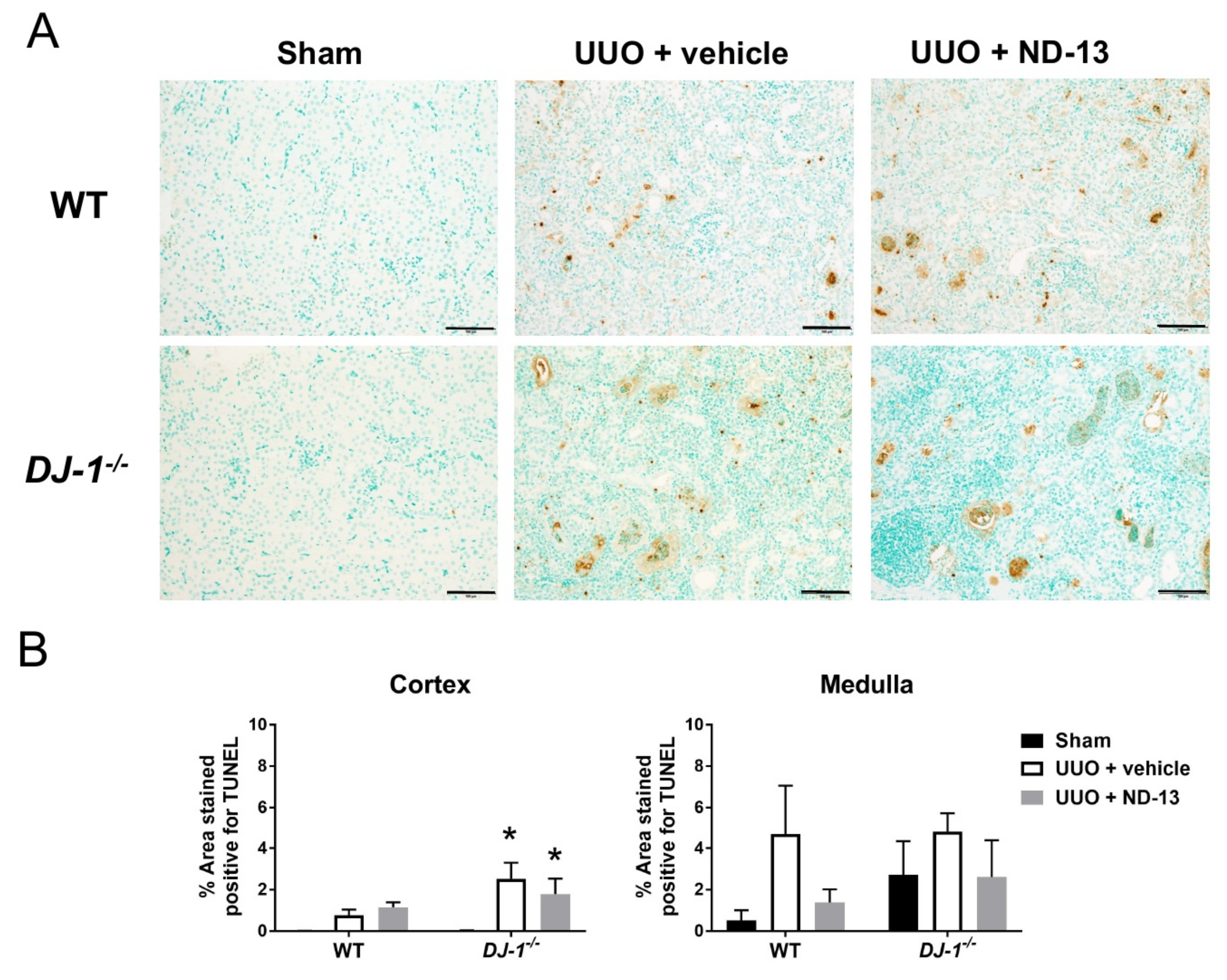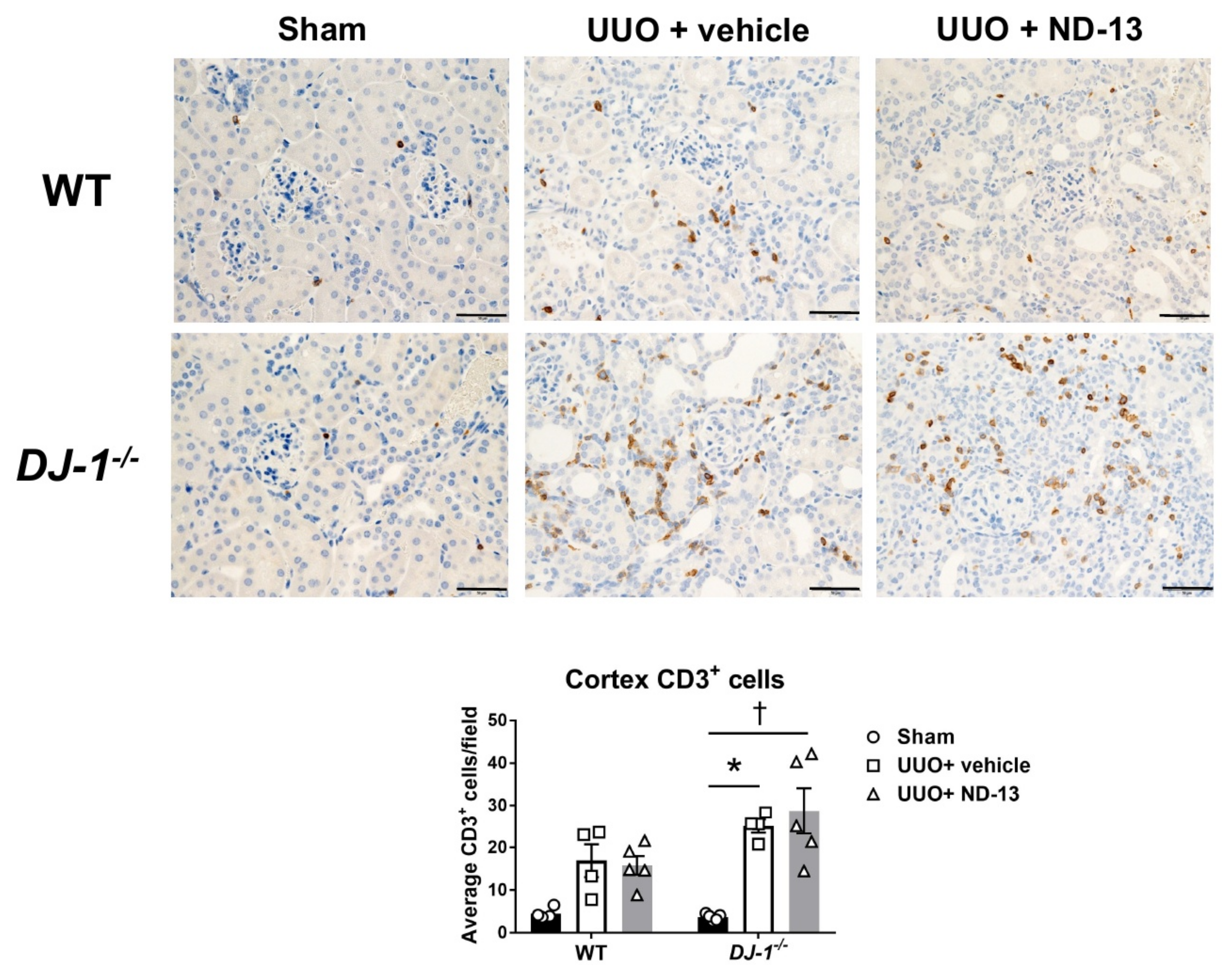ND-13, a DJ-1-Derived Peptide, Attenuates the Renal Expression of Fibrotic and Inflammatory Markers Associated with Unilateral Ureter Obstruction
Abstract
1. Introduction
2. Results
2.1. ND-13 Treatment Reduces UUO-Induced Renal Fibrosis in WT Mice, but Not in DJ-1−/− Mice
2.2. Treatment with ND-13 Does Not Prevent UUO-Induced Cell Death in the Kidney
2.3. Renal Expression of Cytokine and Chemokine Genes Associated with UUO is Ameliorated in Mice Treated with ND-13
2.4. ND-13 Treatment Attenuates the UUO-Induced Cortical Macrophage Inflammation in WT Mice, but not in DJ-1−/− Mice, While not Preventing the Infiltration of T-Lymphocytes in Either Genotype
2.5. ND-13 Does Not Improve the Renal Damage Score in UUO Mice
3. Discussion
4. Materials and Methods
4.1. Animal Studies
4.2. Quantitative RT-PCR
4.3. Histology and Fibrosis Quantification
4.4. Immunohistochemistry and Quantification of Immune Cell Infiltration in the Kidney
4.5. Terminal Deoxynucleotidyl Transferase-Mediated dUTP Nick-End Labeling (TUNEL) Assay and Quantification
4.6. Urinary NGAL Measurements
4.7. Renal Damage Evaluation
4.8. Statistical Analysis
Supplementary Materials
Author Contributions
Funding
Acknowledgments
Conflicts of Interest
Abbreviations
| UUO | Unilateral ureter obstruction |
| Col1a1 | Collagen 1a1 |
| Nrf2 | Nuclear factor erythroid 2-related factor 2 |
References
- Giacco, F.; Brownlee, M. Oxidative stress and diabetic complications. Circ. Res. 2010, 107, 1058–1070. [Google Scholar] [CrossRef] [PubMed]
- Navarro-Gonzalez, J.F.; Mora-Fernandez, C. The role of inflammatory cytokines in diabetic nephropathy. J. Am. Soc. Nephrol. 2008, 19, 433–442. [Google Scholar] [CrossRef] [PubMed]
- Lee, S.B.; Kalluri, R. Mechanistic connection between inflammation and fibrosis. Kidney Int. 2010, 78, S22–S26. [Google Scholar] [CrossRef] [PubMed]
- Imig, J.D.; Ryan, M.J. Immune and inflammatory role in renal disease. Compr. Physiol. 2013, 3, 957–976. [Google Scholar] [CrossRef]
- Anders, H.J.; Ryu, M. Renal microenvironments and macrophage phenotypes determine progression or resolution of renal inflammation and fibrosis. Kidney Int. 2011, 80, 915–925. [Google Scholar] [CrossRef] [PubMed]
- Duffield, J.S. Macrophages and immunologic inflammation of the kidney. Semin. Nephrol. 2010, 30, 234–254. [Google Scholar] [CrossRef]
- Cao, Q.; Harris, D.C.; Wang, Y. Macrophages in kidney injury, inflammation, and fibrosis. Physiology 2015, 30, 183–194. [Google Scholar] [CrossRef] [PubMed]
- Kisseleva, T.; Brenner, D.A. Fibrogenesis of parenchymal organs. Proc. Am. Thorac. Soc. 2008, 5, 338–342. [Google Scholar] [CrossRef]
- Brenmoehl, J.; Miller, S.N.; Hofmann, C.; Vogl, D.; Falk, W.; Scholmerich, J.; Rogler, G. Transforming growth factor-beta 1 induces intestinal myofibroblast differentiation and modulates their migration. World J. Gastroenterol. 2009, 15, 1431–1442. [Google Scholar] [CrossRef][Green Version]
- Meng, X.M.; Nikolic-Paterson, D.J.; Lan, H.Y. Inflammatory processes in renal fibrosis. Nat. Rev. Nephrol. 2014, 10, 493–503. [Google Scholar] [CrossRef]
- Lv, W.; Booz, G.W.; Wang, Y.; Fan, F.; Roman, R.J. Inflammation and renal fibrosis: Recent developments on key signaling molecules as potential therapeutic targets. Eur. J. Pharmacol. 2018, 820, 65–76. [Google Scholar] [CrossRef] [PubMed]
- Nagakubo, D.; Taira, T.; Kitaura, H.; Ikeda, M.; Tamai, K.; Iguchi-Ariga, S.M.; Ariga, H. DJ-1, a novel oncogene which transforms mouse NIH3T3 cells in cooperation with ras. Biochem. Biophys. Res. Commun. 1997, 231, 509–513. [Google Scholar] [CrossRef] [PubMed]
- Liu, F.; Nguyen, J.L.; Hulleman, J.D.; Li, L.; Rochet, J.C. Mechanisms of DJ-1 neuroprotection in a cellular model of Parkinson’s disease. J. Neurochem. 2008, 105, 2435–2453. [Google Scholar] [CrossRef] [PubMed]
- Zhou, W.; Freed, C.R. DJ-1 up-regulates glutathione synthesis during oxidative stress and inhibits A53T alpha-synuclein toxicity. J. Biol. Chem. 2005, 280, 43150–43158. [Google Scholar] [CrossRef] [PubMed]
- Junn, E.; Jang, W.H.; Zhao, X.; Jeong, B.S.; Mouradian, M.M. Mitochondrial localization of DJ-1 leads to enhanced neuroprotection. J. Neurosci. Res. 2009, 87, 123–129. [Google Scholar] [CrossRef]
- Cuevas, S.; Zhang, Y.; Yang, Y.; Escano, C.; Asico, L.; Jones, J.E.; Armando, I.; Jose, P.A. Role of renal DJ-1 in the pathogenesis of hypertension associated with increased reactive oxygen species production. Hypertension 2012, 59, 446–452. [Google Scholar] [CrossRef]
- Shelton, L.M.; Park, B.K.; Copple, I.M. Role of Nrf2 in protection against acute kidney injury. Kidney Int. 2013, 84, 1090–1095. [Google Scholar] [CrossRef]
- Li, W.; Khor, T.O.; Xu, C.; Shen, G.; Jeong, W.S.; Yu, S.; Kong, A.N. Activation of Nrf2-antioxidant signaling attenuates NFkappaB-inflammatory response and elicits apoptosis. Biochem. Pharmacol. 2008, 76, 1485–1489. [Google Scholar] [CrossRef]
- Kobayashi, E.H.; Suzuki, T.; Funayama, R.; Nagashima, T.; Hayashi, M.; Sekine, H.; Tanaka, N.; Moriguchi, T.; Motohashi, H.; Nakayama, K.; et al. Nrf2 suppresses macrophage inflammatory response by blocking proinflammatory cytokine transcription. Nat. Commun. 2016, 7, 11624. [Google Scholar] [CrossRef]
- Cuevas, S.; Yang, Y.; Konkalmatt, P.; Asico, L.D.; Feranil, J.; Jones, J.; Villar, V.A.; Armando, I.; Jose, P.A. Role of nuclear factor erythroid 2-related factor 2 in the oxidative stress-dependent hypertension associated with the depletion of DJ-1. Hypertension 2015, 65, 1251–1257. [Google Scholar] [CrossRef]
- De Miguel, C.; Hamrick, W.C.; Sedaka, R.; Jagarlamudi, S.; Asico, L.D.; Jose, P.A.; Cuevas, S. Uncoupling Protein 2 Increases Blood Pressure in DJ -1 Knockout Mice. J. Am. Heart Assoc. 2019, 8, e011856. [Google Scholar] [CrossRef] [PubMed]
- Sun, Q.; Shen, Z.Y.; Meng, Q.T.; Liu, H.Z.; Duan, W.N.; Xia, Z.Y. The role of DJ-1/Nrf2 pathway in the pathogenesis of diabetic nephropathy in rats. Renal Fail. 2016, 38, 294–304. [Google Scholar] [CrossRef] [PubMed]
- Lev, N.; Barhum, Y.; Ben-Zur, T.; Aharony, I.; Trifonov, L.; Regev, N.; Melamed, E.; Gruzman, A.; Offen, D. A DJ-1 Based Peptide Attenuates Dopaminergic Degeneration in Mice Models of Parkinson’s Disease via Enhancing Nrf2. PLoS ONE 2015, 10, e0127549. [Google Scholar] [CrossRef] [PubMed]
- Glat, M.J.; Ben-Zur, T.; Barhum, Y.; Offen, D. Neuroprotective Effect of a DJ-1 Based Peptide in a Toxin Induced Mouse Model of Multiple System Atrophy. PLoS ONE 2016, 11, e0148170. [Google Scholar] [CrossRef] [PubMed]
- Lev, N.; Barhum, Y.; Lotan, I.; Steiner, I.; Offen, D. DJ-1 knockout augments disease severity and shortens survival in a mouse model of ALS. PLoS ONE 2015, 10, e0117190. [Google Scholar] [CrossRef]
- Centers for Disease Control and Prevention. Chronic Kidney Disease in the United States, 2019; US Department of Health and Human Services, Centers for Disease Control and Prevention: Atlanta, GA, USA, 2019. [Google Scholar]
- Higgins, G.C.; Coughlan, M.T. Mitochondrial dysfunction and mitophagy: The beginning and end to diabetic nephropathy? Br. J. Pharmacol. 2014, 171, 1917–1942. [Google Scholar] [CrossRef]
- Mihai, S.; Codrici, E.; Popescu, I.D.; Enciu, A.M.; Albulescu, L.; Necula, L.G.; Mambet, C.; Anton, G.; Tanase, C. Inflammation-Related Mechanisms in Chronic Kidney Disease Prediction, Progression, and Outcome. J. Immunol. Res. 2018, 2018, 2180373. [Google Scholar] [CrossRef]
- Han, Y.; Ma, F.Y.; Tesch, G.H.; Manthey, C.L.; Nikolic-Paterson, D.J. Role of macrophages in the fibrotic phase of rat crescentic glomerulonephritis. Am. J. Physiol. Renal Physiol. 2013, 304, F1043–F1053. [Google Scholar] [CrossRef]
- Song, C.J.; Zimmerman, K.A.; Henke, S.J.; Yoder, B.K. Inflammation and Fibrosis in Polycystic Kidney Disease. Results Probl. Cell Differ. 2017, 60, 323–344. [Google Scholar] [CrossRef]
- Ma, Z.; Jin, X.; He, L.; Wang, Y. CXCL16 regulates renal injury and fibrosis in experimental renal artery stenosis. Am. J. Physiol. Heart Circ. Physiol. 2016, 311, H815–H821. [Google Scholar] [CrossRef]
- Hill, G.S.; Delahousse, M.; Nochy, D.; Thervet, E.; Vrtovsnik, F.; Remy, P.; Glotz, D.; Bariety, J. Outcome of relapse in lupus nephritis: Roles of reversal of renal fibrosis and response of inflammation to therapy. Kidney Int. 2002, 61, 2176–2186. [Google Scholar] [CrossRef] [PubMed]
- Brennan, E.P.; Cacace, A.; Godson, C. Specialized pro-resolving mediators in renal fibrosis. Mol. Asp. Med. 2017, 58, 102–113. [Google Scholar] [CrossRef] [PubMed]
- Martinez-Klimova, E.; Aparicio-Trejo, O.E.; Tapia, E.; Pedraza-Chaverri, J. Unilateral Ureteral Obstruction as a Model to Investigate Fibrosis-Attenuating Treatments. Biomolecules 2019, 9. [Google Scholar] [CrossRef] [PubMed]
- Chevalier, R.L.; Forbes, M.S.; Thornhill, B.A. Ureteral obstruction as a model of renal interstitial fibrosis and obstructive nephropathy. Kidney Int. 2009, 75, 1145–1152. [Google Scholar] [CrossRef]
- Leeds, J.; Scindia, Y.; Loi, V.; Wlazlo, E.; Ghias, E.; Cechova, S.; Portilla, D.; Ledesma, J.; Swaminathan, S. Protective Role of DJ-1 in Endotoxin-induced Acute Kidney Injury. Am. J. Physiol. Renal Physiol. 2020. [Google Scholar] [CrossRef]
- Niture, S.K.; Khatri, R.; Jaiswal, A.K. Regulation of Nrf2-an update. Free Rad. Biol. Med. 2014, 66, 36–44. [Google Scholar] [CrossRef]
- Sun, Q.; Shen, Z.Y.; Duan, W.N.; Meng, Q.T.; Xia, Z.Y. Mechanism of myocardial ischemia/reperfusion-induced acute kidney injury through DJ-1/Nrf2 pathway in diabetic rats. Exp. Ther. Med. 2017, 14, 4201–4207. [Google Scholar] [CrossRef][Green Version]
- Schmidlin, C.J.; Dodson, M.B.; Zhang, D.D. Filtering through the role of NRF2 in kidney disease. Arch. Pharm. Res. 2019. [Google Scholar] [CrossRef]
- Clements, C.M.; McNally, R.S.; Conti, B.J.; Mak, T.W.; Ting, J.P. DJ-1, a cancer- and Parkinson’s disease-associated protein, stabilizes the antioxidant transcriptional master regulator Nrf2. Proc. Natl. Acad. Sci. USA 2006, 103, 15091–15096. [Google Scholar] [CrossRef]
- Gan, L.; Johnson, D.A.; Johnson, J.A. Keap1-Nrf2 activation in the presence and absence of DJ-1. Eur. J. Neurosci. 2010, 31, 967–977. [Google Scholar] [CrossRef]
- Himmelfarb, J.; Tuttle, K.R. New therapies for diabetic kidney disease. N. Engl. J. Med. 2013, 369, 2549–2550. [Google Scholar] [CrossRef] [PubMed]
- Rossing, P. Diabetic nephropathy: Could problems with bardoxolone methyl have been predicted? Nat. Rev. Nephrol. 2013, 9, 128–130. [Google Scholar] [CrossRef] [PubMed]
- Li, Z.; Xie, W.B.; Escano, C.S.; Asico, L.D.; Xie, Q.; Jose, P.A.; Chen, S.Y. Response gene to complement 32 is essential for fibroblast activation in renal fibrosis. J. Biol. Chem. 2011, 286, 41323–41330. [Google Scholar] [CrossRef] [PubMed]








| Body Weight (g) | ||||||
|---|---|---|---|---|---|---|
| Pre | Post | Gain/Loss | ||||
| Mean | SEM | Mean | SEM | Mean | SEM | |
| WT sham | 28.75 | 3.22 | 28.85 | 2.90 | 0.10 | 0.38 |
| DJ-1−/− sham | 25.38 | 1.58 | 25.74 | 1.62 | 0.36 | 0.09 |
| WT vehicle | 23.30 | 2.05 | 23.94 | 2.00 | 0.64 | 0.31 |
| DJ-1−/− vehicle | 26.20 | 3.12 | 26.40 | 3.18 | 0.20 | 0.16 |
| WT ND-13 | 28.72 | 2.89 | 29.26 | 2.76 | 0.54 | 0.76 |
| DJ-1−/− ND-13 | 24.80 | 3.40 | 25.02 | 4.01 | 0.22 | 0.34 |
| Food Intake (g) | ||||||
| Pre | Post | Net | ||||
| Mean | SEM | Mean | SEM | Mean | SEM | |
| WT sham | 75.85 | 0.57 | 72.40 | 2.95 | 3.45 | 2.57 |
| DJ-1−/− sham | 74.00 | 3.74 | 70.84 | 2.99 | 3.16 | 1.14 |
| WT vehicle | 70.66 | 3.89 | 64.80 | 3.87 | 5.86 | 1.88 |
| DJ-1−/− vehicle | 74.50 | 4.08 | 71.70 | 4.16 | 2.80 | 0.42 |
| WT ND-13 | 71.06 | 3.14 | 65.56 | 3.76 | 5.50 | 1.29 |
| DJ-1−/− ND-13 | 71.78 | 3.02 | 68.53 | 3.21 | 3.25 | 1.41 |
| Water Intake (mL) | ||||||
| Pre | Post | Net | ||||
| Mean | SEM | Mean | SEM | Mean | SEM | |
| WT sham | 53.43 | 6.34 | 50.73 | 7.44 | 2.70 | 1.31 |
| DJ-1−/− sham | 55.44 | 4.97 | 51.48 | 3.90 | 3.96 | 1.60 |
| WT vehicle | 55.08 | 2.22 | 49.98 | 3.89 | 5.10 | 1.82 |
| DJ-1−/− vehicle | 57.90 | 6.12 | 54.25 | 6.02 | 3.65 | 0.53 |
| WT ND-13 | 56.08 | 1.93 | 50.34 | 2.28 | 5.74 | 0.57 |
| DJ-1−/− ND-13 | 59.58 | 2.75 | 55.45 | 2.22 | 4.13 | 1.97 |
| Urine (mL) | ||||||
| Mean | SEM | |||||
| WT sham | 0.63 | 0.28 | ||||
| DJ-1−/− sham | 0.69 | 0.32 | ||||
| WT vehicle | 1.10 | 0.36 | ||||
| DJ-1−/− vehicle | 1.18 | 0.28 | ||||
| WT ND-13 | 1.86 | 0.65 | ||||
| DJ-1−/− ND-13 | 1.38 | 0.51 | ||||
© 2020 by the authors. Licensee MDPI, Basel, Switzerland. This article is an open access article distributed under the terms and conditions of the Creative Commons Attribution (CC BY) license (http://creativecommons.org/licenses/by/4.0/).
Share and Cite
De Miguel, C.; Kraus, A.C.; Saludes, M.A.; Konkalmatt, P.; Ruiz Domínguez, A.; Asico, L.D.; Latham, P.S.; Offen, D.; Jose, P.A.; Cuevas, S. ND-13, a DJ-1-Derived Peptide, Attenuates the Renal Expression of Fibrotic and Inflammatory Markers Associated with Unilateral Ureter Obstruction. Int. J. Mol. Sci. 2020, 21, 7048. https://doi.org/10.3390/ijms21197048
De Miguel C, Kraus AC, Saludes MA, Konkalmatt P, Ruiz Domínguez A, Asico LD, Latham PS, Offen D, Jose PA, Cuevas S. ND-13, a DJ-1-Derived Peptide, Attenuates the Renal Expression of Fibrotic and Inflammatory Markers Associated with Unilateral Ureter Obstruction. International Journal of Molecular Sciences. 2020; 21(19):7048. https://doi.org/10.3390/ijms21197048
Chicago/Turabian StyleDe Miguel, Carmen, Abigayle C. Kraus, Mitchell A. Saludes, Prasad Konkalmatt, Almudena Ruiz Domínguez, Laureano D. Asico, Patricia S. Latham, Daniel Offen, Pedro A. Jose, and Santiago Cuevas. 2020. "ND-13, a DJ-1-Derived Peptide, Attenuates the Renal Expression of Fibrotic and Inflammatory Markers Associated with Unilateral Ureter Obstruction" International Journal of Molecular Sciences 21, no. 19: 7048. https://doi.org/10.3390/ijms21197048
APA StyleDe Miguel, C., Kraus, A. C., Saludes, M. A., Konkalmatt, P., Ruiz Domínguez, A., Asico, L. D., Latham, P. S., Offen, D., Jose, P. A., & Cuevas, S. (2020). ND-13, a DJ-1-Derived Peptide, Attenuates the Renal Expression of Fibrotic and Inflammatory Markers Associated with Unilateral Ureter Obstruction. International Journal of Molecular Sciences, 21(19), 7048. https://doi.org/10.3390/ijms21197048








